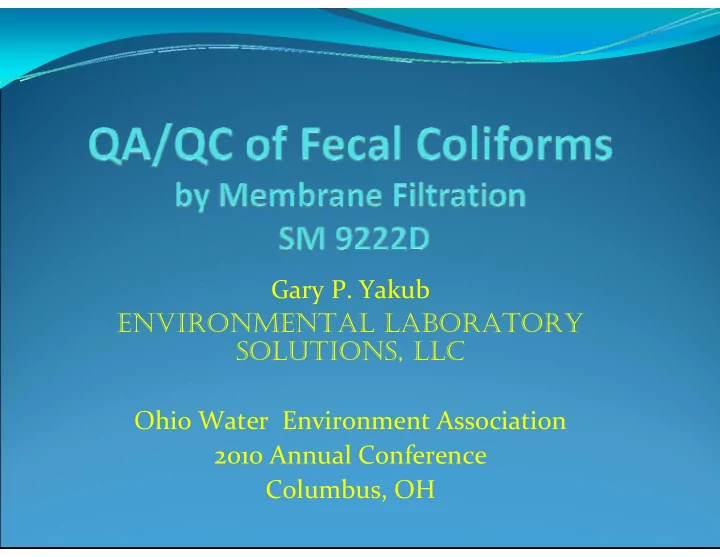

Gary P. Yakub ENVIRONMENTAL LABORATORY SOLUTIONS, LLC Ohio Water Environment Association 2010 Annual Conference Columbus, OH
Introductory Concepts How is Microbiology QC Different than Wet Chem QC? Living Organisms in a Living System Extreme Variability Difficulty in Preparing Known Standards Control of Variables Becomes Extremely Important False Positives and False Negatives Different Types of Calculations to Account for Variability www.envirolabsolutions.com 2
The Parts of SM that nobody reads… SM Section 9020B – Intra ‐ Laboratory QC SM Section 9030 – Laboratory Apparatus SM Section 9040 – Washing & Sterilization SM Section 9050 – Prep of Culture Media SM Section 9060 – Samples SM Method 9222B – Total Coliform by MF www.envirolabsolutions.com 3
Review of Methodology Choice of Methodology Collection and Aliquoting of Sample Sample Filtration/Filtration Sequence Contamination Blanks Incubation Reading the Plates Calculation of Coliform Density www.envirolabsolutions.com 4
Review of Calculations Target Range – 20 to 60 cfu per plate Three Usual Scenarios: One or More Plates in Range All Plates Below Range All Plates Above Range www.envirolabsolutions.com 5
One or More Plates in Range Example: 100ml = 95 Do not use 50ml = 42 Use Result 25ml = 20 Use Result 10ml = 6 Do not use (Count/Volume) x 100 (42/50)x100 = 84 (20/25)x100 = 80 Average 84 + 80 = (164/2) = 82 Final Answer. www.envirolabsolutions.com 6
All Plates Below Range Example: 100ml = 18 Do not use 50ml = 7 Do not use 25ml = 2 Do not use 10ml = 0 Do not use Divide Total Counts by Total Volume (x 100) (18+7+2+0)/(100+50+25+10) x100 (27/185) x 100 = 14.59 = 15 Final Answer Note: If no colonies on any plates, report as “<1 cfu/100ml” www.envirolabsolutions.com 7
All Plates Above Range Example: 100ml = TNTC Do not use 50ml = TNTC Do not use 25ml = 187 Do not use 10ml = 80 Do not use Calculate plate with highest count, report as “>” (187/25)x100 = 748 = >748 Final Answer Note: Report “TNTC” if colony count exceeds 200 www.envirolabsolutions.com 8
Geometric Mean Data Set for Five Days: D1 = 15, D2 = 8, D3 = 28, D4 = 182, D5 = 22 Arithmetic Mean: (15+8+28+182+22)/5 = (255/5) = 51 Geometric Mean: (15 x 8 x 28 x 182 x 22) 1/5 = (13,453,440) 1/5 = 26.7 = 27 www.envirolabsolutions.com 9
Duplicate Precision Standard Methods Section 9020B8a4: “Perform duplicate analyses on 10% of samples and on at least one sample per test run…” Standard Methods Section 9020B8b: “Calculate precision of duplicate analyses for each different type of sample examined…” Standard Methods Section 9020B8a2: “For routine performance evaluation, repeat counts on one or more positive samples at least monthly…should agree within 5% for same analyst and 10% for different analysts…” www.envirolabsolutions.com 10
Duplicate Precision Calculation of Duplicate Precision 1. Perform Duplicate Analyses on 15 Positive Samples 2. Record Results as D1 and D2 3. Calculate the Logarithm of Each Result. For Any Results of “<1”, Add 1 to Each Duplicate Result. 4. Calculate the Range of the Log Values. 5. Calculate the Average Range. 6. Calculate the Control Limit, Which is Defined as: 3.27 x Average Range. www.envirolabsolutions.com 11
Duplicate Precision Example: Sample Set D1 D2 L1 L2 Range (L1 ‐ L2) 1 89 71 1.9494 1.8513 0.0981 2 38 34 1.5798 1.5315 0.0483 3 58 67 1.7634 1.8261 0.0627 15 110 121 2.0414 2.0828 0.0414 Avg = 0.0626 Duplicate Precision Control Limit = 3.27 x 0.0626 Duplicate Precision Control Limit = 0.2047 Analyze Daily Duplicate, Transform, Compare! www.envirolabsolutions.com 12
9020B Personnel Trained Microbiologist or Access to One for Guidance Supervisory Review Training and Skills www.envirolabsolutions.com 13
9020B Facilities Ventilation Space Utilization Bench Area Walls and Floors Laboratory Cleanliness www.envirolabsolutions.com 14
9020B Equipment Thermometers Balances pH Meters Autoclaves Refrigerators Freezers Membrane Filtration Equipment Water Bath Incubators www.envirolabsolutions.com 15
9020B Laboratory Supplies Glassware Detergent Reagents Volumetric Sample Containers Membrane Filters www.envirolabsolutions.com 16
Media Lab ‐ Prepared vs Ready ‐ to ‐ use pH Verification Receipt & Storage Positive & Negative Controls www.envirolabsolutions.com 17
9020B SOPs Document Analytical Procedures Document Quality Assurance Procedures Document Sample Handling Document Data Handling www.envirolabsolutions.com 18
9020B Sampling Sampling Plan Proper Technique to Avoid Contamination Container, Preservation, Holding Times www.envirolabsolutions.com 19
9020B Analytical Methods 40CFR Part 136 Multiple Tube Fermentation Membrane Filtration Defined Substrate Methodology www.envirolabsolutions.com 20
9020B Verification Standard Methods Section 9020B9b2: “Verify positives monthly by picking at least 10 blue colonies from one positive sample. Verify in Lauryl tryptose broth and EC broth as in 9221B3 and 9221E…” www.envirolabsolutions.com 21
9020B Documentation Quality Assurance Manual SOPs Data Quality Management Plan Benchsheets Ask This Question: “ Can I trace all equipment, reagents, media, and samples from the final result back through any preparations to the origins of the test?” www.envirolabsolutions.com 22
Questions? Thank you for attending! Contact Gary P. Yakub at: ENVIRONMENTAL LABORATORY SOLUTIONS, LLC PO Box 440, Quakertown, PA 18951 267 ‐ 377 ‐ 5934 gary1412@comcast.net www.envirolabsolutions.com www.envirolabsolutions.com 23
Recommend
More recommend